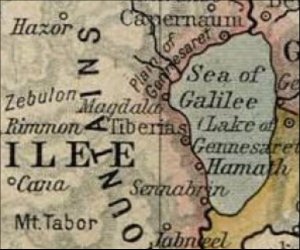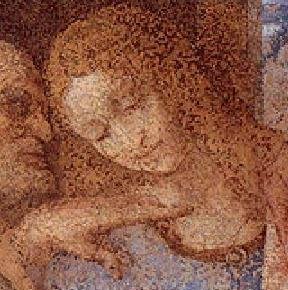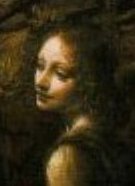The Gospels of Nag-Hammadi
Dialog of the Savior is the title of the writing that relates the following events. "Three disciples received special instructions from Jesus, Thomas, Andrew and Mary Magdala, whom Jesus placed above the other two, ...because she spoke as the woman who understands completely." These same scriptures call Mary Magdala "visionary" and a disciple who outranks the others. According to the Gospel of Philip, "competition broke out among the male disciples because of Mary Magdala, whom Jesus considered his innermost companion and the symbol of wisdom; because he loved her more than his other disciples, and often kissed her." In light of the above, we can now also understand why Jesus appears first to Mary Magdala after his resurrection. We can also see that Mary Magdala is Jesus' disciple and one of the twelve apostles, despite Judeo-Christianity's refusal to acknowledge her as either a disciple or as an apostle. To this day, it has portrayed her in the mind of the believer as "an unprincipled" woman. But let us have a look at this elusive, supposedly "unprincipled" personage.
First, let us examine her name. Mary Magdalene is a name given by Roman Orthodoxy, a rework of her authentic name Magdala, used in gnostic literature. The meaning of her name, Magdala, is a reference to her place of origin, a city on the west shore of the Lake Galilee: Mag-Da-La, “Radiant City of Magi” in Sumerian-Aramaic, its etymology being, Mag, wise; Da, of (place name suffix); La, illuminating, radiant, figuratively, perfect. (Mag-Da, Magda, is a common Hungarian girls' name to this day.)

Town of Magdala on the west shore of Lake (Sea of) Galilee.
Now that we know the meaning of her name, as well as her place of origin in Galilee, let us see what one prominent 15th century artist knew about her. Leonardo daVinci clearly knew about Mary Magdala as Jesus' beloved—and more. In his 1498 painting, The Last Supper, a female figure with girlish face, long hair and lowered eyes occupies the place of honor on Jesus' right, while all the others look ahead. In those days, it was not proper for women to raise their eyes in the company of men. Even today, the Hungarian expression for lowered-eyes (szemérmes) is the word for chaste, reticent. So the question begs: did Leonardo still know back in 1498 that Mary Magdala was the "favorite" disciple at the occasion of the Lord's Supper described by John as "resting on Jesus' bosom at the supper"? Also interesting are the glasses on the table and the biscuit-size buns. In those days, production of glassware of the purity shown in the painting was limited to Egypt and Mesopotamia. And the price of such glassware competed with that of wares made of gold, possibly surpassing it. Wherever glasses of such quality were found on a table, it was a sign that the company present are from the highest social class. Their bread consists of tiny buns, typical Scythian-Hun staple food. It is conceivable that Italian artists familiar with, and regularly working in the Vatican, came across writings that spoke of these biscuit-size buns, writings which have since disappeared.


Figure sitting on Jesus' right. Of significance is the choice of colors for the clothing of the figure sitting on Jesus' right, red cape over a blue dress: the exact mirror image of Jesus' clothing—a combination worn by no one else present. Anyone who sees a man in this picture...

DaVinci painted Mary Magdala's face using the same model who posed for the angel in his Madonna of the Rocks. Artists have always used female models to depict adult angels.
But let us look further. Let us take a look at the Gospel of Philip where Jesus teaches us about life as human beings. "Fear not the flesh nor love it. If you fear it, it will gain mastery over you. If you love it, it will absorb you and paralyze you." Later, he gives this law: "Great is the mystery of marriage. For without it, the world would not exist. Now the existence of the world depends on Man, and the existence of Man depends on marriage." So let us not wonder why the early Jesus Faith, devoid of any Paulist ideology, revered Mary Magdala as Jesus' beloved. This fact gains further credence in the canonized Gospel of John, where she is the first person to go to Jesus' tomb, "early in the morning, while it was still dark" (20:1), and runs to inform Peter and the disciples. Let us think human for a moment:
-
Jesus considers her first in his earthly life;
-
Jesus considers her the first among his disciples;
-
She is the faithful spouse who is the first one at Jesus' tomb;
-
Jesus shows himself first to her and speaks first to her after his resurrection;
-
Jesus often kisses her (There is a hole in the text following the verb kiss. Some claim that Jesus kisses Mary on her mouth, others dismiss such claims. So far, our knowledge of the Coptic language does not provide clues either way. However, in Hungarian there two verbs for kiss, and one of them, “csókol,” generally means kiss on the mouth.)
It is noteworthy that in John's writings, Mary addresses Jesus as Rabboni, which, according to the canonized Gospel of John means master (variably, teacher or, the more cheeky translation, rabbi):
"Jesus saith unto her, Mary. She turned herself, and saith unto him, Rabboni; which is to say, Master" (John 20:16).
However, Sumerian-Aramaic, Ra-Ba-Ni does not mean either master or teacher, and definitely not rabbi, not even by the most convoluted translation. Ra-Ba-Ni means "Light of the World."
Hopefully, we are not demeaning Jesus if we believe him to be a real, living person whose life—even in a human perspective—is complete. After all, it is in the union of man and woman that divine blessing is realized according to God's plan of blissful life. It is God who planted in Man's heart the magical sensation of being in love from which the "great mystery of marriage" issues. And, according to Jesus' law, without that marriage, the world would not exist. What damage could befall our spiritual world if we were to become convinced through logical deduction that Jesus, the Son of God, who took on a human body filled with the same blood as ours, the Son of Man, showed us example here, too? This was to be the only way for him to fulfill the divine will to become human.
The Gospel of Philip also tell us something else; something about Jesus' Mother, the Virgin Mary, whom Jesus also identifies with another face of the Holy Trinity, the Holy Spirit.
"The Spirit, Mother and Virgin, spouse of the heavenly Father. The Father of All joined with the Virgin, who came down. This is the Holy Spirit, who descended to the World. Jesus was born of this Holy Spirit" (62-66).
So what should we understand by the expression Holy Spirit? Better yet, let us ask what did the authors of these scriptures understand by this expression? The Book of Secrets of Nag-Hammadi answers. "She is the invisible, Virgin, Perfect Spirit. She became the Mother of all that exists, because she existed before all else." And, Jesus speaks this way:
"Just now my mother, the Holy Spirit, took me by one of my hairs and carried me to Tabor, the great mountain..." [Mount Tabor is 17 Km. west of Lake Galilee].

So it seems that, at the spiritual level, Jesus refers to his mother as the Holy Spirit. This relationship is depicted on the 12th century fresco titled Holy Trinity, showing Father, Mother, Son, located in ancient “Avar” territory, today's Urschalling, a town on the Austrian-German border near Lake Chiemsee (The “Avar” Empire, centered in the Carpathian Basin, stretched from the Balkans to today's France). This fresco had survived the ideologies of the Holy Roman Empire until the 16th century when the picture of the “Mother” was painted over. But, when the paint started to peal off, she reemerged from the original pigmentation of the plaster during restoration in the 1920s. No records of the painted image could be located, but locals speculate that depicting her anatomically correct was an affront to 16th century Christian morality. A more likely (but equally speculative) assumption, based on other 16th century Christian art depicting the Holy Spirit, is that an image of a pigeon was painted over her.
And now we know a little more about the Scythians' spiritual beliefs. We also found one of the twelve apostles, Mary Magdala. We can now turn to history in our search for Jesus' Truth.

